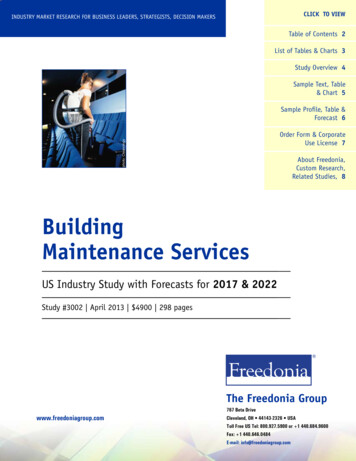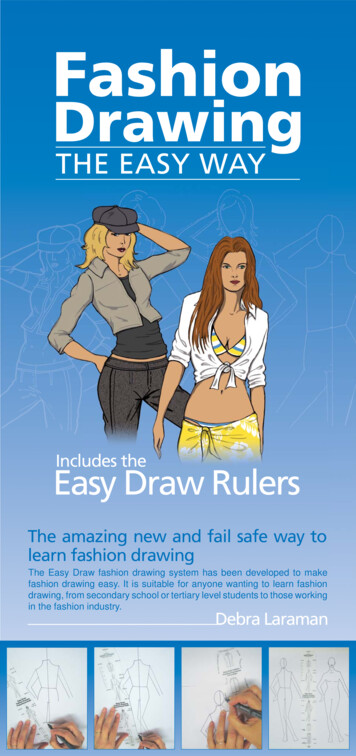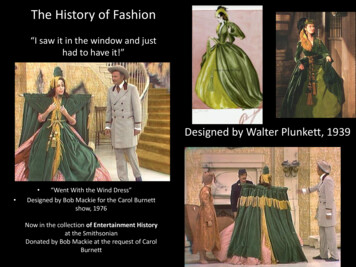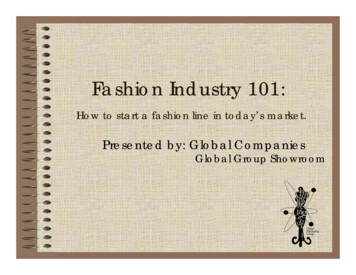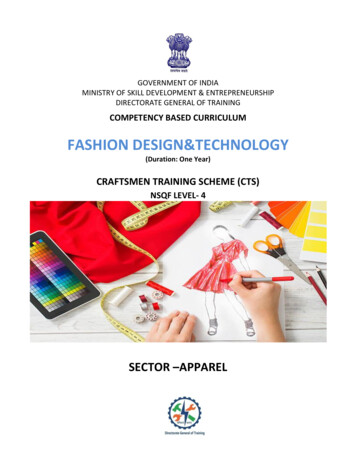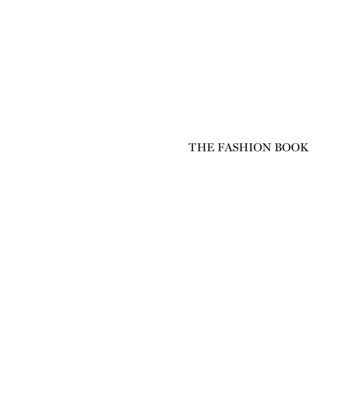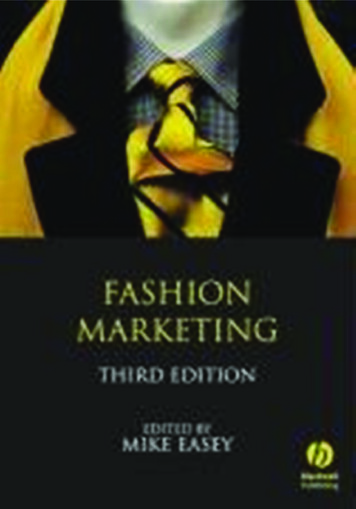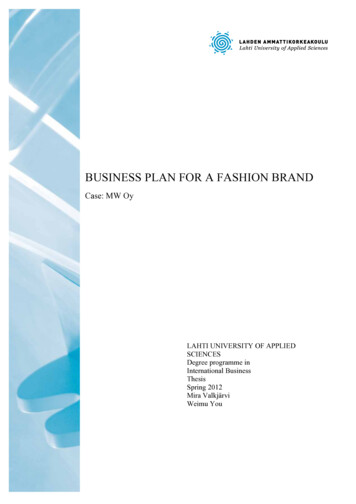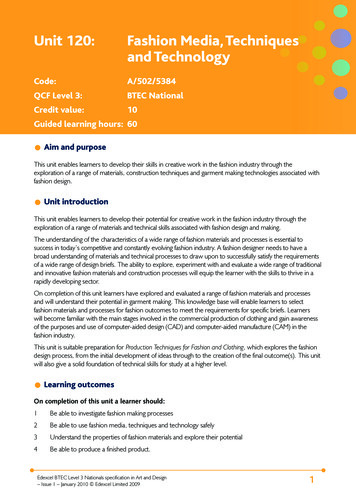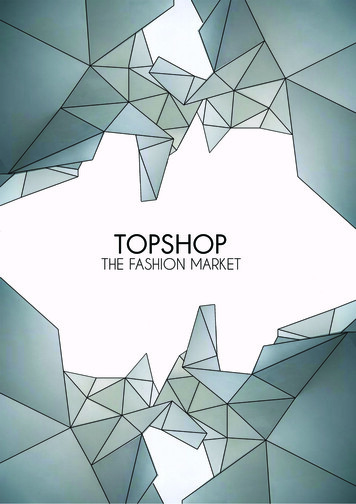
Transcription
THE FASHION MARKET
CONTENTSEXECUTIVE SUMMARYMACRO TO MICRO VIEUW POINTMICRO TRENDSEGMENTATION, TARGETING AND POSITIONINGUK’S MARKET OVERVIEWPESTLE AnalysisPORTER’s FIVE FORCESBRAND OVERVIEWSEGMENTATIONCONSUMER PROFILEPEN PORTRAITCOMPETITORSPOSITIONINGCHALLENGES & OPPORTUNITIESRANGECONCLUSIONAPPENDICESBIBLIOGRAPHY
EXECUTIVE SUMMARYThis marketing report aims to provide an analysisof the fashion retailer Topshop, following on fromthe group research process in the Macro environment. It evaluates the current position andproduct strategy of the firm and proposes a newrange under a new sub-brand for a defined targetmarket inspired by an autumn/winter 14/15 microtrend. This report is underpinned by an extensivemarket research and by both primary and secondary research that comprises a range of data collection gathered from Keynote and National statisticsand visits to museums and current exhibitions.
MACRO TO MICRO VIEUW POINTA Macro trend is a ‘large social, economic, political, andtechnological change that is slow to form, and once in place,influences us for some time - between seven and ten years,or longer’ (Kotler, 2012) They vary in size, stability, geographical distribution and longevity but are an order of magnitudemore stable than any other trend.By investigating short and long term social, economic andpolitical drivers of change we tried to identified the zeitgeist,the spirit of our time that will influence a Macro trend, whichwill have an impact on the upcoming season and will endure for years to come. The Mega trend identified within mygroup was New Reality. Stemming from Newism, New Realityis based on a culture of change from current global observations. It is about looking to a future that brings a new andimproved way of living and achieving futuristic goals thanksto the developments in technology and materials, therefore providing more imaginative products and services. Thefuture technology will produce new commodities that will bemore surprising, convenient and intuitive than establishedalternatives. As Catherine Wales told BoF on 3D printing, thistechnology holds the promise of a world where imaginationhas no boundaries. Technology is bringing a new level ofinteraction and entertainment to the retail environment andthe shopping experience (Warc, 2013).As well as that, we are currently embarking on an era of spaceexploration and Sci-fi materials are now becoming a reality,for example Aerographite, which according to WGSN, is theworld’s lightest material and can conduct electricity. Currentexhibitions, like Out of Hand: Materializing the Postdigital,in New York, show how new inventions such as 3D printing,CNC (or computer numerically controlled) machining, ordigital knitting and weaving are already with us. The relationship between humans and machines is evolving into something new and this is changing the face of consumerism, howwe work and what we do for a living: Consumers are becoming more and more entrepreneurial, always experimentingwith new ideas and embracing technology; and the number ofconsumers experimenting with digital DIY to make new andfun products keeps growing (WGSN, 2013). The never-endingpossibilities of innovation will no doubt contribute to buildinga culture of creativity in the future. The volume and pace ofinnovation is faster than ever, with more and more individualsletting their imagination run free in order to create new products and services. New technologies will give more freedom tothe individual and digital manufacturing has already taken animportant role in contemporary art, design and architecture.Designers and artists are progressively influenced by thesenew technologies and the inspirational shapes, structures andtextures they can create.
MICRO TRENDFor my micro trend I have decided to focus on the influences of 3D printing which, according to Obama, is ‘the nextrevolution in manufacturing’. This technology has existed for quite some time now, but its cost meant that wassomething that only mega -corporations could consider.Now this technology has reached its first real highpointof accessibility to the general public, thus making pricesdrop significantly; an entry-level 3D printer is only 900,for example (BoF, 2012). The ‘3D: Printing the future’ exhibition in London shows how this technology is nowstarting to be brought to a bigger market through manufacturing processes, interior, fashion and even medicine.Digital technologies are emerging in fashion design enabling a whole new level of craft production and opening thedoor to a world of possibilities. Arising from New Reality,‘De-structured’ is a micro trend influenced by 3D printing.This technology allows designers to completely break withthe usual shape of the garments, allowing them to createall sorts of new and exciting silhouettes, thus the name ofthe micro trend. Another key aspect of this concept are theprints and patterns inspired by the polygonal and geometrical shapes that can be created with 3D printers. It can taketraditional shapes to a whole new level of geometry and precision and create intricate dimensions and impossible facets.
A few of the drivers of this micro trend are designers such as Dutch Iris van Herpen, who is pioneeringthis type of manufacturing with the creation of theotherworldly, computer-generated dresses (Dazed,2012) or Michael Schmidt’s 3D-printed dress, whichwas tailored to Dita von Teese’s exact body measurements. Art is one of the domains that benefitsthe most from 3D printing technologies. Americanartist Joshua Harker has created a complex seriescalled “Tangle” where he breaks the perceived limits of manufacturing. Frank Stella is another artistwho experiments with 3D printing to create largescale sculptures. Textile designers Claudio Granato& Enrico Pieraccioli created a collection of patternsbased on natural formations and subsequently filtered through parametric drawings and 3-D printingtechniques to achieve multidimensional effects.
One of the core colours of this micro trend is grey. It willemerge as a new neutral and used with lighter and darker shadesto add depth and dimension. Tonal greys layered together areset to be a hugely popular colour combination for the season.The choice of materials for 3D printing is very limited and so arethe colors, white, black and silver being the most common ones,which has turned them into some of the core colors of this microtrend. Smoke blue hues will be the secondary colours coming together with the above mentioned for an enduring and functionalcolour palette (see colour mood board).One of the key elements of this micro trend are the stand outabstract prints inspired in 3D holographic patterns, crystallinestructures, diagonal stripes, geometric forms and linear grids.Another element are the sophisticated surface reliefs which create a surface texture without print or colour for a modern finish.Raised relief patterns will create a structured 3D effect on thesurface of materials such as leather or neoprene, a perfect wayto add a sophisticated edge to contemporary mens and womenswear. If a greater variety of materials could be used in 3D printing, the options for product development would immediatelyexpand. So far, plastics and nylons have been the most successful. The shapes of the garments are sharp and angular, with anarchitectural tailoring but always keep a clean and polished look.Materials for this micro trend will include sustainable polyesterlightweights, wovens and knits available in classic greys and natural fibers bringing sophistication to next-generation techy textileswith a metallic shine look and silver influences. Tactility is a keystatement for fashion materials with new quilting popping up viatechnology.
SEGMENTATION, TARGETINGAND POSITIONINGUK’S MARKET OVERVIEWONS estimates of the quantity bought in the retailindustry continue to show growth. In November 2013,it increased by 2.0% compared with November 2012.According to Keynote (Clothing Retailing Market Report2013) a positive growth is forecast and consumers areencouraged to shop as the economy recovers. The totalconsumer expenditure on clothing in the UK reached 49.78bn in 2012, achieving a substantial growth, as in2009 sales had gone down to 41.87bn. The women’sgarments sector is recognised as highly competitivedue to the growth of the market size and the supplyof similar products; it accounted for a value of 23,5bnin 2012. Some of the main competitors in the industryare Arcadia Group Ltd, Hennes & Mauritz Ltd, InditexGroup UK Ltd, New Look Retail Group Ltd, PrimarkStores Ltd, Next PCL and Marks and Spencer PCL (KeyNote, 2013).PESTLE AnalysisPolitical environment-The fashion industry is often directly affected by political decisions, such as laws and regulations. UK’s regulatory system provides a stable political environment.Regarding the political risks on a global basis, the UK iscategorised as one of the countries in the world with“the lowest risk” (Griffin, 2010). This factor provides astable environment for businesses to operate in the UK.
Economic environment-The British economy is considered one of the most globalised in the world, London being one of thelargest financial centres.- Despite being a member state of the EU, the UK still uses the Pound Sterling (GBP) as its currency. Inthe short term the Pound is quite stable.-The clothing retail industry in the UK is expected to see changes in the near future. Since we are currently, albeit slowly, coming out of the recession, prices have started to rise steadily, the price of thecotton is continuously increasing as well (Cotton Inc., 2013), and this will have an impact on Topshoptargeted segments, as it might increase the garments’ pricingSocial Environment-The population in the UK was 63.7 million in December 2013 (ONS, 2013) and it is ranked as one ofthe most developed countries when it comes to standard of living, education and healthcare. The population of Britain could more than double in the next century unless immigration is tightly controlled,according to official estimates showing it could grow 40 per cent faster than previously thought (Telegraph, 2013)- According to Mintel the female population is expected to increase, which will affect the womenswearmarket, as women are considered to be the biggest spenders on clothing. Because they are Topshop’stargeted segment, this fact might have an impact on their sales in the coming years. Moreover, overweight has become an issue: over a quarter of the women in the UK are considered obese. This willlead to more demand for larger sized clothing, as well as shapewear (Mintel, 2010c).Technological Environment-Findings by the Centre of Retail Research (CRR), forecast that e-commerce retailing will experience a14% increase in sales in 2011 (CRR, 2011). In connection with the continuously growing Internet web,online retailing has become more mainstream, giving retailers an opportunity to stay in touch withtheir target audience. Moreover, Mintel (2010b) states that women are the most active users of onlinefashion.-Social media: Having a presence in social networks such as Twitter or Facebook allows access to liveinformation involving the consumer and making him/her feel more connected to the brand.Legal Environment-Due to the financial crisis and the UK’s budget distresses, national legislation increased the valueadded tax by 2.5% in January 2011. This is a factor that will have a direct effect on the prices offered toconsumers (Key Note, 2011a).Environmental-In 2008 the government launched a “green initiative” to influence and increase environmental awareness in the country. Consumers are increasingly demanding more sustainable brands. Topshop, forexample, launched a collection made entirely from discarded textiles, including surplus stock andproduction offcuts and signed up ‘The Sustainable Clothing Action Plan (Arcadia Group responsibilitiesreport 1013).-Furthermore, unpredictable weather caused by global warming has also had an impact on clothingretailers: it has made it much more difficult for apparel retailers to plan the two- season collectionsystem (Autumn/Winter and Spring/Summer) and is something Topshop will have to take into consideration, since this situation has pushed brands and retailers to design transnational ranges of clothesthat can be worn in different seasons (Mintel, 2008).
PORTER’s FIVE FORCESI used Porter’s Five Forces model (1980) to analyse Topshop’s competitive environment (see Appendix 1) and establish a good overview of the typical patterns amongthe biggest competitors in the market. The threat of newentrants always exists but is not very high for Topshop;being a well-established brand, new entrants wouldn’tbe able to compete with its offer and good retail sites inmost UK towns are already taken by the major UK-ownedretail groups. The intensity of rivals is very high and Topshop has to face strong competition from internationalbrands with similar prices and products such as Zara andH&M. This is further discussed in the section on competitors. The threat of substitute products is low as clothes areessential and will always be needed. Substitutes for Topshop are likely to be other high-street brands, however, thedifferences in prices keep off a distinctive need to switch(Key Note, 2011). Suppliers’ power has decreased because of competition from low-wage countries like China and India and since Topshop is part of a large international store group, it has a strong bargaining powerover suppliers. Lastly, the bargaining power of buyersis considered moderate because all buyers are individual consumers, which decreases their bargaining position. However, Topshop being a fast fashion brand meansit has the obligation to offer buyers what they demand.
TOPSHOPBRAND OVERVIEWTopshop was launched in 1964 by Peter Robinson and focuses on up-todate affordable fashion. The brand hosts around 300 stores in the UKand 140 international
PESTLE Analysis. Political environment-The fashion industry is often directly affected by politi-cal decisions, such as laws and regulations. UK’s regu- latory system provides a stable political environment. Regarding the political risks on a global basis, the UK is categorised as one of the countries in the world with “the lowest risk” (Griffin, 2010). This factor provides a stable .


